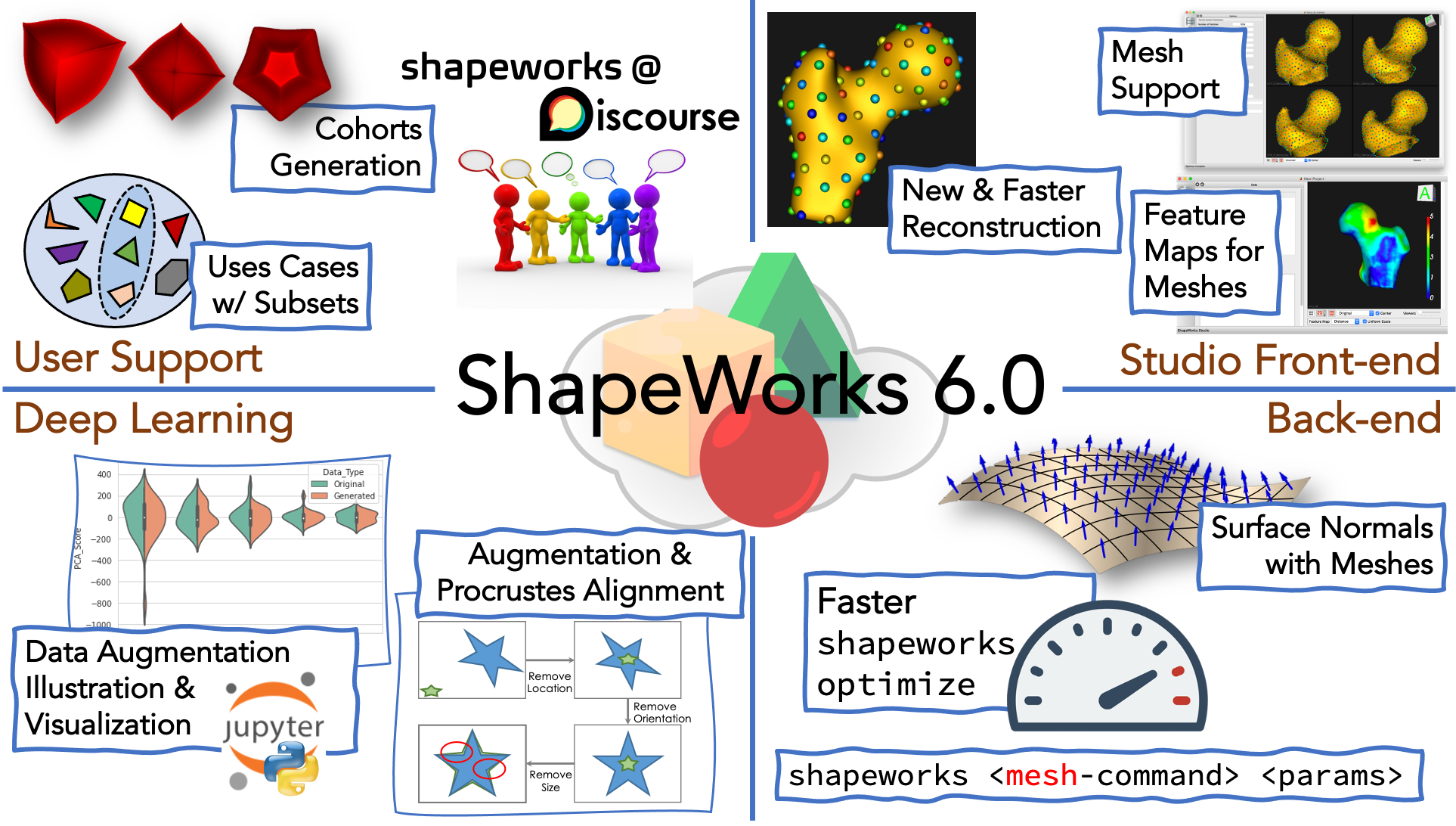To download installation packages for Windows/Mac/Linux and/or the source code, please visit https://github.com/SCIInstitute/ShapeWorks/releases/tag/v6.0.0

Mesh Support in Studio & More ...
Mesh support in Studio: Added support for mesh inputs with minimal grooming. See New in ShapeWorksStudio for more details.New and faster surface reconstruction: Added a new surface reconstruction method with support for both mesh and image inputs. This method is much faster and is the new default. See New in ShapeWorksStudio for more details.
Feature maps support for meshes: Added support for loading and displaying scalar values from mesh inputs. See New in ShapeWorksStudio for more details.
Faster Optimization, Mesh Commands & More ...
Support for use_normals with meshes: Added support for surface normals when optimizing directly on meshes. This results in improved shape models on thin domains. See ShapeWorks Directly on Meshes for more details.Consolidation of mesh-based grooming tools: Updated the shapeworks API to include mesh-based grooming tools. Added mesh-based query tools. This also includes a full complement of unit tests.
Enable multi-threading on Mac platforms: Switched from OpenMP to TBB (thread building blocks), allowing multithreading on Mac. Performance improvements include a ~4X speedup on Mac laptop and same speed or better on Linux/Windows.
Performance improvements in shapeworks optimize: ~20% faster optimization in mesh and image domains by replacing specific data structures (that were initially in place to allow interactive removal of particles during the optimization). ~50% faster optimization in mesh domain by caching nearest-triangle lookups.
Improved Data Augmentation for DeepSSM & More ...
DeepSSM now saves both the "best" and "final" model: The final model is saved after all training epochs have run. The best model is saved after the epoch that had the lowest prediction error on the validation set. The best model makes use of early stopping to prevent overfitting. See SSM Directly from Images for more details.Visualization of DeepSSM errors: The error meshes that are output from running the DeepSSM use case can now be visualized in Studio. These meshes have a distance scalar field that captures the distance between the true and predicted mesh. See SSM Directly from Images for more details.
Data augmentation handles modeling scenarios that need Procrustes alignment: Data augmentation can now be run on a dataset for which Procrustes was used in optimization. When both the local and world .particle files are passed as arguments for data augmentation, the translation is accounted for in the augmented data. See Data Augmentation for Deep Learning for more details.
Visualizing data augmentation: Parallel violin plots are used to compare the distribution of real and augmented data visually. See Visualizing Data Augmentation for more details.
Demonstrating data augmentation: A Jupyter notebook that demonstrates the data augmentation process has been added. In this notebook, parallel violin plots are used to compare the distribution of real and augmented data visually.
Improved Use Cases & More ...
New discussion forum: The official discussion forum for ShapeWorks has been launched. This forum is a place for ShapeWorks users to discuss how to customize shape modeling workflows for their own use cases, troubleshoot issues end-users facing when using ShapeWorks, keep track of suggestions to improve the software and documentation, and ensure awareness of the latest ShapeWorks tools within the research community.Tiny tests for use cases: All use cases now have a tiny test that can be run using the --tiny_test option. When the tiny test is run, only the data necessary for the test is downloaded rather than all of the data. See ShapeWorks Use Cases for more details.
Running use cases on subsets: All of the use cases (mesh or segmentation based) can now be run on a subset of the data using the --use_subsample option. Note that the entire dataset is downloaded in this case so that a subset that is representative of the entire dataset can be selected. See ShapeWorks Use Cases for more details.
Generating shape cohorts: Example shape cohorts with analytic correspondences can now be generated using the ShapeWorks package GenerateShapeCohort. Currently, cohorts of parameterized ellipsoids or supershapes can be generated. Options are available to specify the degree to which the cohort is groomed (i.e., a cohort can be generated to be in alignment or misaligned in various ways). These cohorts can help with troubleshooting the shape modeling workflow. See this notebook that demonstrates cohort generation using the GenerateShapeCohort package.
Other Improvements
- Detailed optimization progress: Added particle count, initialization/optimization phase, and iteration count on the status bar in addition to the progress bar. (user feature request)
- Improved Studio viewer: Added ability to use 2 viewers (in between 1 and 4). Added ability to choose orientation marker (medical, triad) and location (corner).
- Improved Studio interface: Added new checkbox for automatic glyph sizing. Added support for drag and drop of images and meshes. Scalar bar color is now opposite of background color (e.g., when the background is white, the text should be dark) (user request).
- Improved responsiveness: Improved particle shape statistics computation speed. Improved user interface responsiveness during optimization. Improved distance transform loading for surface reconstruction.
- Improved error handling: Enhanced error handling and graceful reporting of errors such as attempts to write/save to read-only directories and filesystems.
Contact Us
Discussion forum: Join ShapeWorks' discussion forum to post questions and comments. ShapeWorks dev team is more than happy to help troubleshoot issues that you might face when using ShapeWorks on your data.Email list: To join our mailing list, kindly send a message to
Reporting bugs and feature requests: Please feel free to submit feature requests and report bugs on ShapeWorks GitHub issue tracker and we will add more discussions on the issue as we do progress on this. This will help us prioritize this feature as an action item.
